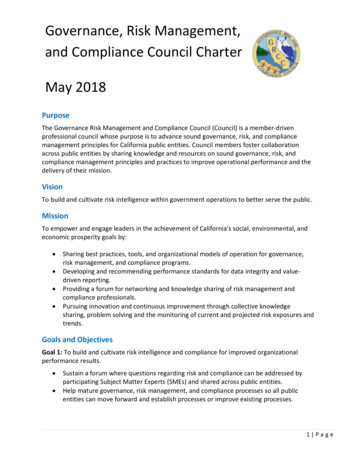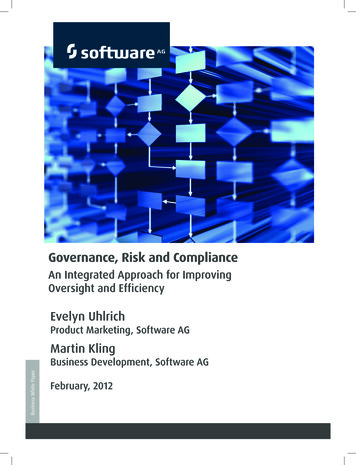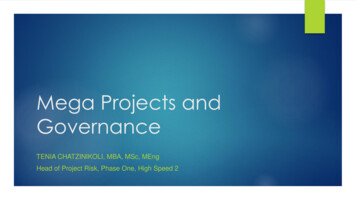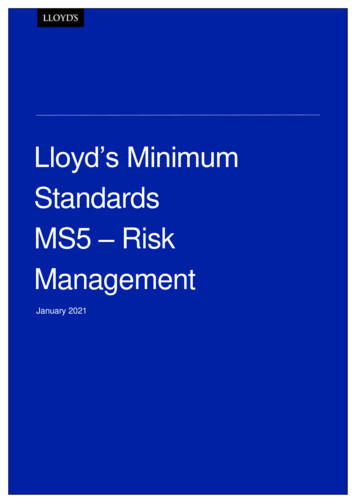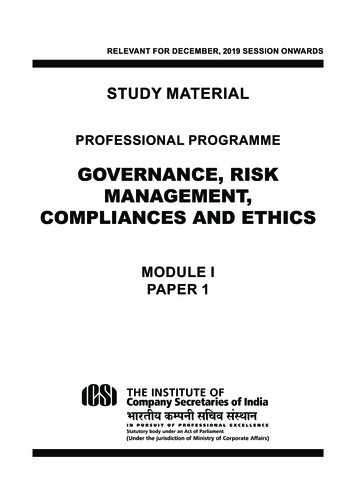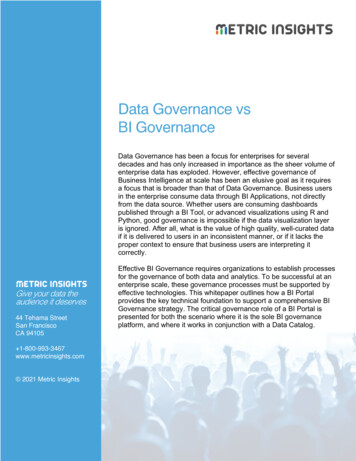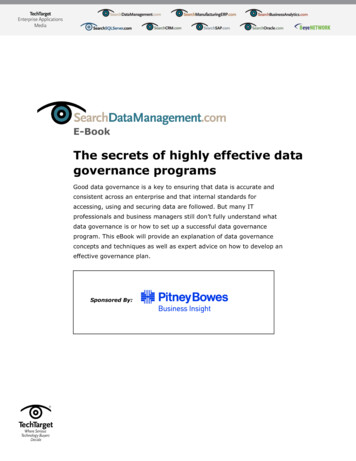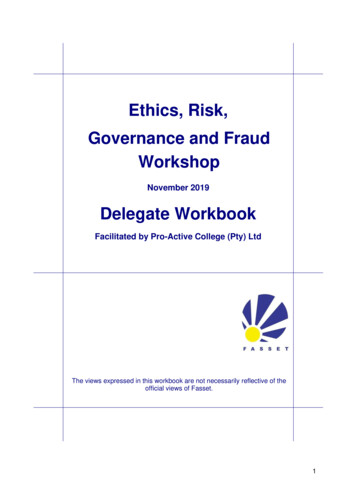
Transcription
STUDY MATERIALPROFESSIONAL PROGRAMMEGOVERNANCE, RISK MANAGEMENT, OMPLIANCES AND ETHICSCMODULE 1PAPER 1
THE INSTITUTE OF COMPANY SECRETARIES OF INDIATIMING OF HEADQUARTERSMonday to FridayOffice Timings – 9.00 A.M. to 5.30 P.M.Public Dealing TimingsWithout financial transactions – 9.30 A.M. to 5.00 P.M.With financial transactions – 9.30 A.M. to 4.00 si.eduE-mailinfo@icsi.eduLaser Typesetting by Satyabrata Mohapatra, Noida andPrinted at HT Media Ltd, Greater Noidaii
PROFESSIONAL PROGRAMMEGOVERNANCE, RISK MANAGEMENT,COMPLIANCES AND ETHICSCorporate governance offers a comprehensive, interdisciplinary approach to the management and control ofcompanies. Corporate professionals of today and tomorrow must imbibe in themselves the evolving principles ofgood corporate governance across the globe on a continual basis. Therefore Corporate Governance has emerged asan important academic discipline in its own right, bringing together contributions from accounting, finance, law andmanagement. Excellence can be bettered only through continuous study, research and academic and professionalinteraction of the highest quality in the theory and practice of good corporate governance. The corporate worldespecially looks upon Company Secretaries to provide the impetus, guidance and direction for achieving world-classcorporate governance. Company Secretaries are the primary source of advice on the conduct of business. This cantake into its fold everything from legal advice on conflicts of interest, through accounting advice, to the developmentof strategy/corporate compliance and advice on sustainability aspects.The paper on Governance, Risk Management, Compliances and Ethics has been introduced to provide knowledgeon global development on governance, risk management, compliances, ethics and sustainability aspects and bestgovernance practices followed worldwide.This Paper is divided into four parts: Part I deals with Governance, Part II deals with Risk Management, Part III dealswith Compliances and Part IV deals with Ethics & Sustainability.Part I elaborates on the conceptual and legal framework of Corporate Governance and the role of Board of Directors,promoters and stakeholders. Part II explains about the Risk identification, its management, mitigation and audit.Part III explains the significance of Compliance and essentials of a compliance management program. This part alsodetails about the Internal Control and Reporting. Part IV details about the relation of Ethics and business. This partalso explains about Sustainability and approaches to measure Business Sustainability.The legislative changes made up to July, 2021 have been incorporated in the study material. The students to beconversant with the amendments to the laws made upto six months preceding the date of examination. It mayhappen that some developments might have taken place during the printing of the study material and its supply tothe students. The students are therefore advised to refer to the updations at the Regulator’s website, Supplementrelevant for the subject issued by ICSI and ICSI Journal Chartered Secretary and other publications for updation ofstudy material.In the event of any doubt, students may write to the Directorate of Academics of the Institute for clarification atacademics@icsi.edu.Although due care has been taken in publishing this study material, the possibility of errors, omissions and/ordiscrepancies cannot be ruled out. This publication is released with an understanding that the Institute shall not beresponsible for any errors, omissions and/or discrepancies or any action taken in that behalf.Should there be any discrepancy, error or omission noted in the study material, the Institute shall be obliged if thesame is brought to its notice for issue of corrigendum in the e-journal ‘Student Company Secretary’.iii
PROFESSIONAL PROGRAMMEGOVERNANCE, RISK MANAGEMENT,COMPLIANCES AND ETHICSObjectiveThis study material is divided into four parts with following weightage of marks:Part I – Governance (50 marks)Part II - Risk Management (20 marks)Part III - Compliances (20 marks)Part IV - Ethics & Sustainability (10 marks)PART I – GOVERNANCECorporate Governance has a broad scope. It includes both social and institutional aspects. Corporate Governanceencourages a trustworthy, moral, as well as ethical environment. In other words, the heart of corporate governanceis transparency, disclosure, accountability and integrity. In the last decade, many emerging markets, internationalbodies, governments, financial institutions, public and private sector bodies have reformed their corporategovernance systems and are encouraging debate and spearheading initiatives towards good corporate governance.Better regulatory and self-regulatory corporate governance frameworks and enforcement mechanisms are beingimplemented through tougher legislations and Corporate Governance Codes.This part of the study apprise about the developments across jurisdictions and brief about the historic origin, needand importance of corporate governance, legislative framework of Corporate Governance explaining the need,scope and evolution of Corporate Governance, Contemporary Developments in Corporate Governance CorporateGovernance codes in major jurisdictions, Corporate Governance in Indian Ethos and family enterprises. This partfurther explains the Board effectiveness, its committees, performance evaluation of Board and role of Promoters.PART II - RISK MANAGEMENTRisk is inherent in every business, whether it is of financial nature or non-financial nature. Thus, management ofthe risk is very important. Risk management begins with the risk identification, analyzing the risk factors, makingassessment of the risk and mitigation of the risk. Better risk management techniques provide early warning signalsso that the same may addressed in time. In traditional concept the natural calamities like fire, earthquake, flood,etc were only treated as risk and keeping the safe guard equipments etc were assumed to have mitigated the risk.But now in the era of fast changing global economy, the management of various types of risks has gained utmostimportance.This part of the study explains the concepts, process, its advantages and steps for implementation of risk management.It also deals with the fraud and reputation risk management and how the negative reputation of an entity may haveadverse impact on the operations and profitability.iv
PART III - COMPLIANCESCompliance means the complete alliance of various parts of the business – whether commercial, financial, orregulatory. It necessitates following the rules, both external and internal. Compliance with law and regulation mustbe managed as an integral part of any corporate strategy. The board of directors and management must recognizethe scope and implications of laws and regulations that apply to the company. They must establish a compliancemanagement system as a supporting system of risk management system as it reduces compliance risk to a greatextent. Compliance with the requirements of law through a compliance management programme can producepositive results at several levels.This part of study explains the adequacy and effectiveness of the compliance system, internal compliance reportingmechanism and ensuring the best practices available for the good governance principles for compliance issues.It further details about the concept of internal control, elements of internal control and its efficacy, concept ofReporting which includes the financial as well as non-financial reporting.PART IV - ETHICS & SUSTAINABILITYBusiness Ethics is the application of ethical principles and methods of analysis to business. In past few decadesbusiness ethics has been given due importance in business, commerce and industry. Promotion of culture of ethicsis an imperative, and it is increasingly being realized that it is the bedrock of good governance which ultimately reinstills the confidence of the stakeholder in the company.Sustainable development is a broad concept that balances the need for economic growth with environmentalprotection and social equity. Sustainability is based on a simple principle: Everything that we need for our survivaland well-being depends, either directly or indirectly, on our natural environment. Sustainability creates andmaintains the conditions under which humans and nature can exist in productive harmony that permits fulfillingthe social, economic and other requirements of the present and future generations.This part of the study elaborates the concept and advantages of business ethics and also explains about corporatesustainability and sustainable development.v
PROFESSIONAL PROGRAMMEModule1Paper1GOVERNANCE, RISK MANAGEMENT,COMPLIANCES AND ETHICS(100 Marks)SYLLABUSObjectivePart-I:To develop skills of high order so as to provide thorough knowledge and insight into the corporategovernance framework, best governance practices.Part–II: To develop skills of high order so as to provide thorough knowledge and insight into the spectrum of risksfaced by businesses.Part-III:To develop the ability to devise and implement adequate and effective systems to ensure compliance ofall applicable laws.Part-IV: To acquire knowledge of ethics in business and framework for corporate sustainability reporting.Detailed ContentsPart I: Governance (50 Marks)1.2.Conceptual Framework of Corporate Governance: Introduction, Need and Scope, Evolution of CorporateGovernance, Management vs. Ownership, Majority vs Minority, Corporate Governance codes in majorjurisdictions, Sarbanes Oxley Act, US Securities and Exchange Commission; OECD Principles of CorporateGovernance; Developments in India, Corporate Governance in Indian Ethos, Corporate Governance –Contemporary Developments.3.Legislative Framework of Corporate Governance in India: Listed Companies, Unlisted Companies, PSUs,Banks and Insurance Companies.4.Board Effectiveness: Composition and Structure, Duties and Liabilities, Evolution of Jurisprudence, Diversityin Board Room, Women Director, Nominee Directors; Selection and Appointment Process, IndependentDirectors: expectations, liabilities and their role, code of conduct, responsibilities and effectiveness.Board Processes through Secretarial Standards.5.Board Committees: Composition & Terms of Reference, Roles and Responsibilities.6.Corporate Policies & Disclosures: Various policies and disclosures to be made as per regulatory requirements/ voluntarily made as part of good governance.vi
7.Directors’ Training, Development and familiarisation.8.Performance Evaluation of Board and Management: Evaluation of the performance of the Board as a whole,individual director (including independent directors and Chairperson), various Committees of the Board andof the management.9.Role of promoter/controlling shareholder, redressal against Oppression and Mismanagement.10. Monitoring of group entities and subsidiaries.11. Accounting and Audit related issues.12. Related Party Transactions.13. Vigil Mechanism/Whistle blower.14. Corporate Governance and Shareholders’ Rights.15. Corporate Governance and other Stakeholders: Employees, Customers, Lenders, Vendors, Government andRegulators, Society, etc.16. Governance and Compliance Risk: Governance/Compliance failure and their impact on business, reputationand fund raising.17. Corporate Governance Forums.18. Parameters of Better Governed Companies: ICSI National Award for Excellence in Corporate Governance.19. Dealing with Investor Associations, Proxy Services Firms and Institutional Investors.20. Family Enterprise and Corporate Governance.Case Laws, Case Studies & Practical Aspects.Part II: Risk Management (20 Marks)21. Risk Identification, Mitigation and Audit: Risk Identification, Risk Analysis, Risk Measurement, RiskMitigation, Risk Elimination, Risk Management Committee, Clarification and Investigation, Role of InternalAudit, Risk Audit, Risk Related Disclosures.Case Studies & Practical Aspects.Part III: Compliances (20 Marks)22. Compliance Management: Essentials of successful compliance program, Significance of Compliance, devisingproper systems to ensure compliance, ensuring adequacy and effectiveness of compliance system, internalcompliance reporting mechanisms, use of technology for compliance management.23. Internal Control: Nature, Scope and Elements, Techniques of Internal Control System, Steps for InternalControl, Efficacy of internal controls and its review.24. Reporting: Integrated Reporting, Non-financial Reporting, Corporate Sustainability Reporting, BoardReporting, Annual Report, Other Reports under LODR, PIT, SAST Regulations.25. Website Management: Meeting through Video Conferencing.Case Studies & Practical Aspectsvii
Part IV: Ethics & Sustainability (10 Marks)26. Ethics & Business: Ethics, Business Ethics, Organization Structure and Ethics, Addressing Ethical Dilemmas,Code of Ethics, Indian Ethos, Designing Code of Conduct, Policies, Fair practices and frameworks.27. Sustainability: Corporate Social Responsibility, Corporate Sustainability Reporting Framework, LegalFramework, Conventions, Treaties on Environmental and Social Aspects, Triple Bottom Line, Principle ofAbsolute Liability - Case Studies, Contemporary Developments, Indian Ethos.28. Models / Approaches to measure Business Sustainability: Altman Z-Score Model, Risk Adjusted Return onCapital, Economic Value Added (EVA), Market Value Added (MVA), Sustainable Value Added Approach.29. Indian and contemporary Laws relating to Anti-bribery: Prevention of corruption Act,1988, CentralVigilance Commission Act, 2003, Lokpal & Lokayukta Act, 2013, Foreign Corrupt Practices Act, 1977, UnlawfulActivities (Prevention) Act, 1967 & Delhi Special Police Establishment Act, 1946; ICSI Anti Bribery Code.Case Studies & Practical Aspectsviii
ARRANGEMENT OF STUDY LESSONSModule 1Paper 1GOVERNANCE, RISK MANAGEMENT,COMPLIANCES AND ETHICSPART I: GOVERNANCELesson No.Lesson Title1Conceptual Framework of Corporate Governance3Board Effectiveness24567891011Legislative Framework of Corporate Governance in IndiaBoard Processes through Secretarial StandardsBoard CommitteesCorporate Policies and DisclosuresAccounting and Audit related issues, RPTs and Vigil MechanismCorporate Governance and Shareholders RightsCorporate Governance and Other StakeholdersGovernance and Compliance RiskCorporate Governance ForumsPART II: RISK MANAGEMENT12Risk Management13Internal Control14ReportingPART III: COMPLIANCEPART IV: ETHICS & SUSTAINABILITY15Ethics and Business17Anti-Corruption and Anti-Bribery Laws in India16CSR and Sustainabilityix
LESSON WISE SUMMARYGOVERNANCE, RISK MANAGEMENT,COMPLIANCES AND ETHICSLesson 1: Conceptual Framework of Corporate GovernanceCorporate Governance is how a corporation is administered or controlled. It is a set of processes, customs, policies,laws and instructions affecting the way a corporation is directed, administered or controlled. The participants in theprocess include employees, suppliers, partners, customers, government, and professional organization regulators,and the communities in which the organization has presence.Corporate Governance is integral to the existence of the company. Corporate Governance is needed to create acorporate culture of transparency, accountability and disclosure.Good corporate governance systems attract investment from global investors, which subsequently leads to greaterefficiencies in the financial sector. The relation between corporate governance practices and the increasinginternational character of investment is very important. International flows of capital enable companies to accessfinancing from a much larger pool of investors. In order to reap the full benefits of the global capital market andattract long-term capital, corporate governance arrangements must be credible, well understood across borders andshould adhere to internationally accepted principles.Corporate governance is a critical factor in economic stability and organisational success. In the last decade, manyemerging markets, international bodies, governments, financial institutions, public and private sector bodies havereformed their corporate governance systems and are encouraging debate and spearheading initiatives towards goodcorporate governance. Better regulatory and self-regulatory corporate governance frameworks and enforcementmechanisms are being implemented through tougher legislations and Corporate Governance Codes.This Lesson gives an overview of the evolution of Corporate Governance worldwide and the existence anddevelopment of corporate governance in India since centuries.Lesson 2: Legislative Framework of Corporate Governance in IndiaThe Companies Act, 2013 which envisages radical changes in the sphere of Corporate Governance in India along with SEBILODR Regulations, 2015 provide for various provisions for good governance of companies. The Companies Act, 2013 isapplicable to all companies registered under the Act and listed companies have to follow SEBI Regulations also. Howeverthe same is not the case with nationalized banks as these are governed by separate Acts. The sector specific companiesi.e. banking/insurance/ public sector are required to follow the regulatory norms prescribed by their sectoral regulator.For example Insurance companies are subject to compliance with IRDA guidelines in addition to other applicablelegislations. The guidelines issued by the IRDA on the Corporate Governance norms applicable to the InsuranceCompany have been dealt with in the chapter.The lesson details the corporate governance developments in Companies, Banks and NBFCs. Also details theguidelines for the insurance companies. Stewardship Code for insurers in India has also been explained. It alsoprovides overview of the governance of Public Sector Enterprises under DPE Guidelines.Lesson 3: Board EffectivenessCompany being an artificial person it requires certain natural persons to represent the company at various fronts. Theposition of directors in their relationship to the company is not only as the agents, but also trustees of the company.x
The Board of Directors plays a pivotal role in ensuring good governance. The contribution of directors on the Boardis critical to the way a corporate conducts itself. A board’s responsibilities derive from law, custom, tradition andprevailing practices.In the present times transparency, disclosure, accountability, issues of sustainability, corporate citizenship,globalization are some of the concerns that the Boards have to deal with. In addition, the Boards have to respond tothe explosive demands of the marketplace. This two dimensional role of the Board of Directors is the cornerstonein evolving a sound, efficient, vibrant and dynamic corporate sector for attaining of high standards in integrity,transparency, conduct, accountability as well as social responsibility.Therefore in this Lesson Board’s role, powers and duties, types of directors required to be appointed under the laws,board composition and role of independent director in ensuring board effectiveness have been discussed.The lesson also gives an insight on training of directors and performance evaluation of directors.Lesson 4: Board Processes through Secretarial StandardsIn general, board process refers mainly to the decision-making activities of the board which need to be performedso that the objectives of the board can be achieved. Decisions relating to the policy and operations of the companyare arrived at meetings of the Board held periodically. Meetings of the Board enable discussions on matters placedbefore them and facilitate decision making based on collective judgment of the Board.The fundamental principles with respect to Board Meetings are laid down in the Companies Act, 2013 and theSecretarial Standard -1 facilitates compliance with these principles by endeavouring to provide further claritywhere there is ambiguity and establishing benchmark standards to harmonise prevalent diverse practices. Forthe benefit of companies, SS-1 provides necessary flexibility in many cases viz. with respect to calling Meetingat shorter notice, transacting any other business not contained in the agenda and passing of Resolutions bycirculation.In this lesson, effective working of Boards through Secretarial Standard- 1 has been discussed.Lesson 5: Board CommitteesA board committee is a small working group identified by the board, consisting of board members, for the purpose ofsupporting the board’s work. Committees are generally formed to perform some expertise work and improve boardeffectiveness and efficiency.Companies Act, 2013 requires certain class of companies to form some committees mandatorily. Similarly SEBI(LODR) Regulations, 2015 makes it mandatory for the listed companies to formulate certain committees of theboard.In this lesson role and functioning various committees like audit committee, stakeholder relationship committee,corporate social responsibility committee is explained.For the prospective company secretaries this lesson shall be useful in performing the advisory role and in compliancemanagement in practical areas of work.Lesson 6: Corporate Policies and DisclosuresA Company has to formulate specific policies in different areas of operations that help to bring uniformity inprocesses by clearly defining the business approach. Some of the policies are legally required, some areorganisational needs and some are voluntarily made as part of good governance. This lesson discusses about variousdisclosure and transparency requirements under Companies Act 2013 and SEBI Regulations.Various disclosures mandatorily required by the companies and listed entities are also elaborated in detail in this chapter.xi
Lesson 7: Accounting and Audit related issues, RPTs and Vigil MechanismCorporate Governance is concerned with holding the balance between economic and social goals and betweenindividual and communal goals. The corporate governance framework is there to encourage the efficient use ofresources and equally to require accountability for the stewardship of those resources. The aim is to align as nearlyas possible the interests of individuals, corporations and society.Good accounting and auditing practices are highly effective as an instrument of corporate governance. CompaniesAct 2013 has provided for various mandatory and voluntary practices to improve financial reporting, internal auditand statutory audit of companies in India. Keeping this in view, this study lesson covers various good governanceinitiatives taken by the government of our country for accounting and audit related issues.It also covers in brief various legal provisions as well as background to related party transactions, meaning of relatedparties, transactions covered under RPT and the procedure for approval etc.At the end, lesson provides brief about vigil mechanism, background of whistle blower concept and various lawspertaining to it.Lesson 8 : Corporate Governance and Shareholders RightsThe central element in corporate governance is the challenges arising out of separation of ownership and control.The shareholders are the true owners of a corporate and the governance function controls the operations of thecorporate. There is a strong likelihood that there is a mismatch between the expectations of the shareholders andthe actions of the management. Therefore there is a need to lay down clearly the rights of the shareholders and thatof the management.SEBI Act, 1992, the various SEBI Regulations and Guidelines and the Companies Act, 2013 enables the empowerment ofshareholder rights. Companies Act, 2013 provides for some measures to protect the interest of minority shareholders.One of the objectives of the SEBI is to provide a degree of protection to the investors and to safeguard their rights,steady flow of savings into market and to promote the development of and regulate the securities market. Investorsshould be safeguarded not only against frauds and cheating but also against the losses arising out of unfair practices.This lesson will enable the students to understand what the rights of the shareholders are and how it is importantfrom corporate governance perspective.Lesson 9: Corporate Governance and Other StakeholdersIn a business context, customers, investors, shareholders, employees, suppliers, government agencies, communitiesand many others who have a ‘stake’ or claim in some aspect of a company’s products, operations, markets, industryand outcomes are known as stakeholders.Stakeholders are characterized by their relationship to the company and their needs, interests and concerns, whichwill be foremost in their minds at the start of an engagement process. However, as the process unfolds they will soontake a particular role with related tasks and responsibilities.A major reason for increasing adoption of a Stakeholder Concept in setting business objectives is the recognitionthat businesses are affected by the “environment” in which they operate. Businesses come into regular contact withcustomers, suppliers, government agencies, families of employees, special interest groups. Decisions made by abusiness are likely to affect one or more of these “stakeholder groups”.Stakeholders can only be well informed and knowledgeable if companies are transparent and report on issues thatimpact stakeholders. Both parties have an obligation to communicate sincerely and attempt to understand, not justbe understood.xii
In this lesson relationship between company and various stakeholders has been discussed and explained how betterstakeholder engagement ensures good governance.Lesson 10: Governance and Compliance RiskHistorically, boards have been perceived to focus primarily on value creation for shareholders. But with renewedattention to statutory compliance, regulators now also want boards to focus on value management and valueprotection by doing a formal review of compliance obligations. As a result, corporations are looking to replaceinformal compliance frameworks with well structured, documented and demonstrable compliance structures thathelp management monitor and report compliance risk and exposure as well as compliance status to the Board.Regulatory compliance is an organization’s adherence to laws, regulations, guidelines and specifications relevant toits business. Violations of regulatory compliance regulations often result in legal punishment, including penalties/fines. As the number of rules has increased since the turn of the century, regulatory compliance has become moreprominent in a variety of organizations. The trend has even led to the creation of corporate, chief and regulatorycompliance officer positions to hire employees whose sole focus is to make sure the organization conforms tostringent, complex legal mandates.This lesson describes the importance compliance and consequences of non compliance. Besides, it also highlightsthe importance of corporate compliance management and compliance risks.Lesson 11: Corporate Governance ForumsThe world has become a borderless global village. The spirit to implement internationally accepted norms of corporategovernance standards found expression in private sector, public sector and the government thinking. The frameworkfor corporate governance is not only an important component affecting the long-term prosperity of companies, but it iscritical in terms of National Governance, Human Governance, Societal Governance, Economic Governance and PoliticalGovernance since the activities of the corporate have an impact on every aspect of the society as such.The need to find an institutional framework for corporate governance and to advocate its cause has resulted in thesetting up and constitution of various corporate governance forums and institutions the world over. In this studylesson we will be discussing with some of the prominent Forums and Institutions of Corporate Governance.Lesson 12: Risk ManagementRisk and reward go hand by hand. We have often heard the statement that without risk there is no gain. Risk isinherent in the business. Different types of risk exist in the business according to the nature of the business and theyare to be controlled and managed.Risk Management is a continuous process of identifying, evaluating and assessing the inherent and potential risk,adopting the methods for its systematic reduction in order to sustainable business development.Companies Act, 2013 provides that a statement indicating development and implementation of a risk managementpolicy for the company including identification therein of elements of risk, if any, which in the opinion of the Boardmay threaten the existence of the company.SEBI (LODR) Regulations, 2015 also provides that company shall lay down procedures to inform Board membersabout the risk assessment and minimization procedures. The Board shall be responsible for framing, implementingand monitoring the risk management plan for the company.The company secretaries are governance professionals whose role is to enforce a compliance framework tosafeguard the integrity of the organization and to promote high standards of ethical behavior. He has a significantrole in assisting the board of the organization to achieve its vision and strategy. The activities of the governancexiii
professional encompass legal and regulatory duties and obligations and additional responsibilities assigned by theemployer.This lesson shall enable the students to understand risk management framework, the definition and types of risks;risk management process; advantages of risk management; steps in risk management; legal provisions on riskmanagement; who is responsible for risk management etc.Lesson 13: Internal ControlInternal control, as defined in accounting and auditing, is a process for assuring achievement of an organization’sobjectives in operational eff
Risk is inherent in every business, whether it is of financial nature or non-financial nature. Thus, management of the risk is very important. Risk management begins with the risk identification, analyzing the risk factors, making assessment of the risk and mitigation of the risk. Better risk management techniques provide early warning signals
